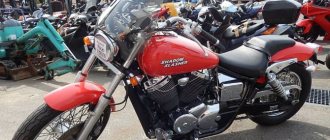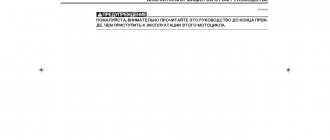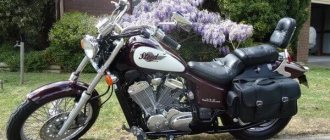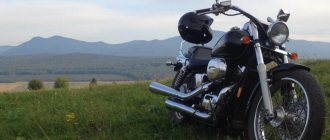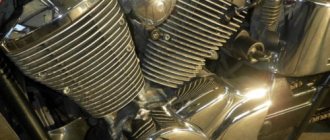Service manual for Honda Shadow / Steed 600/400 (1988-1996). Book in Russian, 287 pages. Repair and maintenance manual for motorcycles Honda Shadow / Steed 600/400 (1988-1996). Contains instructions for disassembling and reassembling all motorcycle components, setup and troubleshooting procedures, and an electrical diagram.
Service manuals for motorcycles translated into Russian. Sold, sent by mail in book form. The work is original and done by hand. Manuals are not distributed electronically! The number of books is gradually increasing.
Books on repair and maintenance of Japanese motorcycles in Russian from the Moto Service Manual publishing house.
We are on VKontakte
Video review of manuals
Books on repair and maintenance of Japanese motorcycles in Russian from the Moto Service Manual publishing house.
Modifications
Shadow 400 Slasher is a popular modification of the model.
- In 2000, the Shadow 400 Slasher appears (in the 750 Shadow Spirit or Shadow 750 Slasher for Japan).
- October 2008 is marked by a massive restyling of both lines. As a result, the Shadow 400 receives the Classic prefix (the appearance becomes similar to the Shadow 750 Aero).
- The Slasher 400 becomes the Shadow 400 Custom (the 750 has a similar model, the VT750C2 Shadow Spirit).
and competitors
However, such a leapfrog of names did not prevent competitors from showing their answers to the 400.
- Kawasaki offered the VN 400 Vulcan.
- Yamaha one of its “shooting stars” XVS 400 Drag Star.
Suzuki has produced as many as 3 versions:
- Intruder VS400;
- Intruder VL400 Classic
- Desperado 400.
Brief history of the model
Model
: Honda Shadow 400 (Japan).
Frame number
: NC34-100XXXX.
Factory designation
: NV400C2V.
Model
: Honda Shadow 400 (Japan).
Frame number
: NC34-110XXXX.
Factory designation
: NV400C2W.
Model
: Honda Shadow 400 (Japan).
Frame number
: NC34-120XXXX, NC34-125XXXX.
Factory designation
: NV400C2X, NV400CX.
Model
: Honda Shadow 400;
Honda Shadow 400 Slasher (Japan). Frame number
: NC34-140XXXX;
NC40-100~, NC40-110~. Factory designation
: NV400C2; NV400DCy.
Model
: Honda Shadow 400;
Honda Shadow 400 Slasher (Japan). Frame number
: NC34-150~;
NC40-120~. Factory designation
: NV400C21; NV400DC1.
Model
: Honda Shadow 400 Slasher (Japan).
Frame number
: NC40-130~.
Factory designation
: NV400DC2.
Model
: Honda Shadow 400 (Japan).
Frame number
: NC34-160~;
NC34-230~. Factory designation
: NV400C23; NV400C3.
Model
: Honda Shadow 400;
Honda Shadow 400 Slasher (Japan). Frame number
: NC34-170~;
NC40-140~. Factory designation
: NV400C4; NV400DC4.
Model
: Honda Shadow 400;
Honda Shadow 400 Slasher (Japan). Frame number
: NC34-180~;
NC40-150~. Factory designation
: NV400C5; NV400DC5.
Model
: Honda Shadow 400;
Honda Shadow 400 Slasher (Japan). Frame number
: NC34-190~;
NC40-160~. Factory designation
: NV400C6; NV400DC6.
Model
: Honda Shadow 400;
Honda Shadow 400 Slasher (Japan). Frame number
: NC34-400~;
NC40-170~. Factory designation
: NV400C7; NV400DC7.
Model
: Honda Shadow 400;
Honda Shadow 400 Slasher (Japan). Frame number
: NC34-410~;
NC40-180~. Factory designation
: NV400C8; NV400DC8.
Model
: Honda Shadow 400 Classic;
Honda Shadow 400 Custom (Japan). Frame number
: NC44-100~;
NC45-100~. Factory designation
: VT400C9, VT400CA9; VT400C29, VT400C2F9.
Model
: Honda Shadow 400 Classic;
Honda Shadow 400 Custom; Honda VT400S (Japan). Frame number
: NC44-100~;
NC45-100~; NC46-100~. Factory designation
: VT400C9, VT400CA9; VT400C29, VT400C2F9; VT400S.
Model
: Honda Shadow 400 Classic;
Honda Shadow 400 Custom; Honda VT400S (Japan). Frame number
: NC44-100~;
NC45-100~; NC46-100~. Factory designation
: VT400C9, VT400CA9; VT400C29, VT400C2F9; VT400S.
Model
: Honda Shadow 400 Classic;
Honda Shadow 400 Custom; Honda VT400S (Japan). Frame number
: NC44-100~;
NC45-100~; NC46-100~. Factory designation
: VT400C9, VT400CA9; VT400C29, VT400C2F9; VT400S.
Model
: Honda Shadow 400 Classic;
Honda Shadow 400 Custom; Honda VT400S (Japan). Frame number
: NC44-100~;
NC45-100~; NC46-100~. Factory designation
: VT400C9, VT400CA9; VT400C29, VT400C2F9; VT400S.
Model
: Honda Shadow 400 Classic;
Honda Shadow 400 Custom; Honda VT400S (Japan). Frame number
: NC44-100~;
NC45-100~; NC46-100~. Factory designation
: VT400C9, VT400CA9;
VT400C29, VT400C2F9; VT400S.
Model
: Honda Shadow 400 Classic (Japan).
Frame number
: NC44-100~.
Factory designation
: VT400C9, VT400CA9.
Model
: Honda Shadow 400 Classic (Japan).
Frame number
: NC44-100~.
Factory designation
: VT400C9, VT400CA9.
Symptoms of engine repair on a Honda VT 400 Shadow are:
- Extraneous noise in the engine
- High oil consumption
- Coolant flow
- Low compression in the engine or large difference between cylinders
- Excessively high compression associated with carbon deposits in the combustion chamber
- Blue smoke from the muffler
- Obvious oil leak from the engine
- Transmission problems
Disassembling a Honda VT 400 Shadow to remove the engine Removing the engine of a Honda VT 400 Shadow Cleaning the engine before disassembling Disassembling the engine Complete troubleshooting of the engine Cleaning the engine of metal shavings and other contaminants Diagnostics of all bearings and gears of the engine Replacement of worn / broken / bent parts Assembling the engine Checking valve clearances mechanism Installing the engine on the Honda VT 400 Shadow Final assembly of the Honda VT 400 Shadow, starting All engine repair work is carried out by a highly qualified mechanic with extensive experience. A 1 year guarantee is provided for all work performed.
Service manual for Honda Shadow/Steed 600/400 (1988-1996)
This time it is a book on repair and maintenance of the Honda Shadow / Steed 600/400 (1988-1996) motorcycle.
Service manual for Honda Shadow / Steed 600/400 (1988-1996). Book in Russian, 287 pages. Repair and maintenance manual for motorcycles Honda Shadow / Steed 600/400 (1988-1996). Contains instructions for disassembling and reassembling all motorcycle components, setup and troubleshooting procedures, and an electrical diagram.
Service manuals for motorcycles translated into Russian. Sold, sent by mail in book form. The work is original and done by hand. Manuals are not distributed electronically! The number of books is gradually increasing.
Andrey Vdovin
"Thanks a lot. The manual is just fire. I found even more in it than I expected. Zhenya, you are a superman. "
Sergey Ignatov
“Zhenya, thank you, the book is brilliant, I’m as happy as an elephant”
Dimych Dubov
". . . I especially liked the posters, a good cheat sheet in the garage. I recommend. "
Books on repair and maintenance of Japanese motorcycles in Russian mockery “Moto Service Manual”.
Evgeniy Ivashchenko
“Previously, I had to service my motorcycle using an English manual. And it was extremely inconvenient."
Driving performance
Due to the production upgrade, the maximum speed increased slightly compared to the prototype - 145 km/h. However, the owners noted that this did not have the best effect on the dynamics.
Dynamics (overclocking)
The 400 is certainly not a liter cruiser; it clearly lacks power on the highway.
A normal cruiser is 100 km/h.
Acceleration from zero to 100 km/h in 11 seconds. When compared with the prototype, users noted that it was almost identical, maybe a fraction of a second faster.
Fuel consumption
According to the manufacturer's documentation, consumption is 2.5 liters per 100 km before restyling in 2008, almost 3 liters after. But since the motorcycle is for the domestic market, the indicators are also indicated in an internal manner. Owners from the Russian Federation note an average consumption of 4.5 liters. A more accurate result depends on the traffic situation.
Provided that the tank is 14 liters, you can drive up to 200 km at one gas station, if “dry” - 280 km.
Release Features
Thus, in 1997, in parallel with the “American shadow” (Shadow 750 ACE), a domestic Japanese version was produced - a smaller engine, power, worse dynamics, but at a very affordable price. Users who saw the new creation were delighted: “Yes, this is a real liter, only less voracious.”
Since the documentation of the bikes went through the factories at the same time, they copied many details from each other. But there is one small detail due to which the motorcycles had different fates.
This is a prototype model. The younger one was planned to replace the Steed 400, and therefore took many parts from it.
The model existed until 2021, receiving restyling in the same years as the older one.
History
| History | ||
| Year | Country | Name/Frame/Engine |
| 1988 | Japan | Name : Honda Steed 400 VLX Frame/Engine : NC26-100XXXX~ Code : NV400Cj |
| 1989 | Japan | Name : Honda Steed 400 VLX Frame/Engine : NC26-105XXXX~ Code : NV400Ck |
| 1990 | Japan | Name : Honda Steed 400 VLX Frame/Engine : NC26-110XXXX~ Code : NV400Cl |
| 1992 | Japan | Name : Honda Steed 400 VLX Frame/Engine : NC26-115XXXX~ Code : NV400Cn |
| 1993 | Japan | Name : Honda Steed 400 VLX Frame/Engine : NC26-120XXXX~ Code : NV400Cp |
| 1994 | Japan | Name : Honda Steed 400 VLX Frame/Engine : NC26-130XXXX~ Code : NV400Cr |
| 1995 | Japan | Name : Honda Steed 400 VLX, Honda Steed 400 VCL, Honda Steed 400 VSE, Honda Steed 400 VSE Frame/Engine : NC26-140XXXX~ (VLX); NC26-139XXXX~ (VCL); NC26-147XXXX~ (VSE) Code : NV400Ct; NV400CVs; NV400CMt |
| 1996 | Japan | Name : Honda Steed 400 VLX, Honda Steed 400 VCL, Honda Steed 400 VSE, Honda Steed 400 VSE Frame/Engine : NC26-150XXXX~ (VLX); NC26-144XXXX~ (VCL); NC26-157XXXX~ (VSE) Code : NV400Cv; NV400CVt; NV400CMv |
| 1998 | Japan | Name : Honda Steed 400 VLX; Honda Steed 400 VLS Frame/Engine : NC26-164XXXX~ (VLX); NC37-100-109XXXX~ (VLS) Code : NV400CBw; NV400CSw |
| 2001 | Japan | Name : Honda Steed 400 VLX Frame/Engine : NC26-210XXXX~, NC26-211XXXX~, NC26-212XXXX~ Code : NV400CB1 |
Diagnostics and replacement of timing chain, repair of timing chain tensioner Honda VT 400 Shadow
Quite often, a malfunction of the Honda VT 400 Shadow timing chain is caused by an increase in the pitch between the links. As a result, the engine begins to idle incorrectly. Therefore, it is not at all surprising that the chain begins to jump several teeth at the same time. What does this mean? Firstly, the engine will stall. Secondly, the valves may be jammed. This, in turn, may require expensive engine repairs. Therefore, when the first signs of a malfunction are detected, it is recommended to replace the timing chain on the Honda VT 400 Shadow.
Specifications
Honda Steed 400: specs.
| Specifications | ||
| DIMENSIONS | Overall length | 2310 mm / 90.9 in 2335 mm / 91.9 in – VLS |
| Overall width | 760 mm / 29.9 in 705 mm / 27.7 in – VLX with drag-bar, VCL 865 mm / 34.0 in – VSE 765 mm / 30.1 in – VLS 890 mm / 35.0 in – VLX (2001) | |
| Overall height | 1130 mm / 44.5 in 1105 mm / 43.5 in – VLX with drag-bar, VCL 1120 mm / 44.1 in – VSE, VLX (2001) 1115 mm / 43.9 in – VLX (1998-2000), VLS | |
| Seat height | 680 mm / 26.7 in 670 mm / 26.4 in – VLX (1998-2001) 650 mm / 25.6 in – VLS | |
| Wheelbase | 1600 mm / 63.0 in 1620 mm / 63.8 in – VLS | |
| Ground clearance | 140 mm / 5.51 in 130 mm / 5.1 in – VLX (1998-2001), VLS | |
| Dry weight | 196 kg / 432 lbs – Steed 400 (1988-1989) 199 kg / 439 lbs – Steed 400 VLX (1990-1992) 201 kg / 443 lbs – Steed 400 VLX (1993) 204 kg / 450 lbs – Steed 400 VLX (1994-1997), VCL 203 kg / 447 lbs – VSE, VLX (1998-2001) 211 kg / 465 lbs – VLS | |
| Curb (wet) weight | 208 kg / 458 lbs – Steed 400 (1988-1989) 211 kg / 465 lbs – Steed 400 VLX (1990-1992) 214 kg / 472 lbs – Steed 400 VLX (1993) 217 kg / 478 lbs – Steed 400 VLX (1994-1997), VCL 216 kg / 476 lbs – VSE 215 kg / 474 lbs – VLX (1998-2001) 223 kg / 491 lbs – VLS | |
| FRAME | Type | Double cradle (steel) |
| Front suspension, travel | Telescopic fork Springer – VLS | |
| Rear suspension, travel | Swingarm with mono-shock | |
| Front tire size | 100/90-19 57S 90/90-21 54S – VLS | |
| Rear tire size | 170/80-15 77S | |
| Front brake | Single disc, 296 mm, 2-piston caliper | |
| Rear brake | Drum | |
| Fuel capacity | 9.0 l / 2.37 US gal – Steed 400 (1988-1992) 11.0 l / 2.90 US gal – Steed 400 (1993-2001) 9.7 l / 2.56 US gal – VLS | |
| Trail | 164 mm (6.45 in) | |
| Fuel economy | 2.78 l / 100 km – (60 km/h) | |
| ENGINE | Type | Water cooled 4-stroke |
| Cylinder arrangement | 2 cylinders V-twin | |
| Bore & Stroke | 64.0 x 62.0 mm | |
| Displacement | 398 cm³ (24.28 cu in) | |
| Compression ratio | 10.0:1 – Steed 400, 1988-1995 9.8:1 – Steed 400, December 1995 to 2001 | |
| Valve train | Chain driven SOHC, 3 valves per cylinder | |
| Max. power | 30.0 hp (22.0 kW) / 7500 rpm – Steed 400 (1988-1994) 31.0 hp (22.8 kW) / 7500 rpm – Steed 400 (1995-2001) | |
| Max. torque | 32.0 Nm (3.3 kg*m/min) / 5500 rpm – Steed 400 (1988-1994) 33.0 Nm (3.4 kg*m/min) / 5500 rpm – Steed 400 (1995-2000) 33.0 Nm (3.4 kg*m/min) / 6000 rpm – Steed 400 (2001) | |
| 0 to 100 km/h (0-60 mph) | 11.1 sec | |
| Top speed | 130 km/h (81 mph) | |
| CARBURETION SYSTEM | Type | Carburetor, 2x Keihin 34 mm |
| ID | VDD 0 | |
| DRIVE TRAIN | Clutch | Wet, multi-plate, cable operated |
| Transmission | 5-speed | |
| Final drive | Chain | |
| Primary reduction | 2.058 | |
| Final reduction | ||
| Gear ratio I II III IV V | 3.000; 3.166 (Steed 400, 1998-2001) 2.055; 2.000 (Steed 400, 1998-2001) 1.590; 1.545 (Steed 400, 1995-1997); 1.500 (Steed 400, 1998-2001) 1.272; 1.200 (Steed 400, 1995-1997); 1.173 (Steed 400, 1998-2001) 1.035; 1.041 (Steed 400, 1998-2001) | |
| ELECTRICAL | Ignition | Full transistor |
| Alternator | 310W at 5000 rpm | |
| Battery capacity | 12V-8Ah |
Specifications
Technical characteristics of Honda Shadow 400:
| Model | Honda Shadow 400 |
| Motorcycle type | cruiser |
| Year of issue | 1997-2016 |
| Frame | steel tubular |
| engine's type | 2-cylinder, 4-stroke, V-shaped |
| Working volume | 398 cm³ |
| Bore/Stroke | 64.0 x 62.0 mm |
| Compression ratio | 9.8:1 – Shadow 400 (1997-2008), Slasher 10.3:1 – Classic, Custom, VT400S |
| Cooling | liquid |
| Number of valves per cylinder | SOHC, 3 valves per cylinder |
| Fuel supply system | Carburetor, 2x Keihin 34 mm – Shadow 400 (1997-2008), Slasher PGM-Fi (electronic injection) – Classic, Custom, VT400S |
| Ignition type | digital transistor |
| Maximum power | 33.0 hp (24.3 kW) at 7500 rpm – Shadow 400 (1997-2008), Slasher 31.0 hp (22.8 kW) at 7000 rpm – Classic, Custom, VT400S |
| Maximum torque | 34 Nm (3.5 kg*m) at 5500 rpm – Shadow 400 (1997-2008), Slasher 33 Nm (3.4 kg*m) at 3500 rpm – Classic, Custom 32 Nm (3.3 kg*m) at 3500 rpm – VT400S |
| Clutch | Multi-disc in oil bath, cable drive |
| Transmission | 5-speed |
| type of drive | Chain – Shadow 400 (1997-2008), Slasher, VT400S Driveshaft – Classic, Custom |
| Front tire size | 100/90-19 (57H) – VT400S 120/90-17 (64S) – Shadow 400 (1997-2008), Classic 110/80-19 (59S) – Shadow 400 Slasher 90/90-21 M/C (54S) – Shadow 400 Custom |
| Rear tire size | 170/80-15M/C (77S) – Shadow 400 (1997-2008) 160/80-15M/C (74S) – Shadow 400 Classic, Custom, Slasher 150/80-B16 M/C (71H) – VT400S |
| Front brakes | 1 disc, 296 mm, 2-piston caliper |
| Rear brakes | drum |
| Front suspension | Telescopic fork, 140 mm – Shadow 400 (1997-2008) Telescopic fork, 108 mm – Shadow 400 Slasher Telescopic fork, 117 mm – Shadow 400 Classic Telescopic fork, 115 mm – Shadow 400 Custom Telescopic fork, 118 mm – VT400S |
| Rear suspension | pendulum with two shock absorbers, 90 mm – Shadow 400 (1997-2008), Classic, Custom, VT400S pendulum with two shock absorbers, 80 mm – Shadow 400 Slasher |
| Motorcycle length | 2455 mm – Shadow 400 (1997-2008) 2310 mm – Shadow 400 Slasher 2510 mm – Shadow 400 Classic 2445 mm – Shadow 400 Custom 2295 mm – VT400S |
| Motorcycle width | 945 mm – Shadow 400 (1997-2008) 795 mm – Shadow 400 Slasher 920 mm – Shadow 400 Classic 835 mm – Shadow 400 Custom 870 mm – VT400S |
| Motorcycle height | 1105 mm – Shadow 400 (1997-2008) 1060 mm – Shadow 400 Slasher 1125 mm – Shadow 400 Classic 1130 mm – Shadow 400 Custom 1135 mm – VT400S |
| Wheelbase | 1625 mm – Shadow 400 (1997-2008), Slasher 1640 mm – Shadow 400 Classic 1655 mm – Shadow 400 Custom 1560 mm – VT400S |
| Seat height | 695 mm – Shadow 400 (1997-2008) 645 mm – Shadow 400 Slasher 660 mm – Shadow 400 Classic 650 mm – Shadow 400 Custom 750 mm – VT400S |
| Minimum ground clearance (clearance) | 140 mm – Shadow 400 (1997-2008) 130 mm – Shadow 400 Slasher, Classic, Custom 155 mm – VT400S |
| Acceleration to 100 km/h | |
| Maximum speed | 145 km/h |
| Gas tank capacity | 14.0 l (including reserve - 3.6 l) – Shadow 400 (1997-2008), Classic, Custom 13.0 l (including reserve – 4.0 l) – Shadow 400 Slasher 10.0 l (including reserve – 2.5 l) – VT400S |
| Motorcycle weight (dry) | 225 kg – Shadow 400 (1997-2008) 217 kg – Shadow 400 Slasher |
| Motorcycle weight (curb) | 242 kg – Shadow 400 (1997-2008) 232 kg – Shadow 400 Slasher 255 kg – Shadow 400 Classic 244 kg – Shadow 400 Custom 229 kg – VT400S |
Valve adjustment Honda VT 400 Shadow
Check the thermal valve clearances according to the service manual for your Honda VT 400 Shadow, as well as after disassembling the head or replacing the timing chain or when a characteristic “clunking noise” appears from the cylinder head.
Increased valve clearances lead to increased noise when the engine is running, and if the clearances are too small, the valves will not close, and the engine will not develop rated power, and sometimes it will be difficult to start.
Our service center provides:
Adjusting valves using a rocker mechanism Adjusting valves using washers (Washers are available for adjusting valves with a diameter of 7.48 mm and 9.48 mm)
Please note that after adjusting the valves, in some cases it is necessary to synchronize the carburetors
Features of HONDA Shadow 400
In terms of its parameters and appearance, the HONDA Shadow 400 is a typical classic cruiser.
Apart from interesting decisions regarding changing the chassis, the bike has few differences.
- Suspension with short travel that cannot be adjusted.
- 2 springs on the rear shock absorber provide a soft ride, but they also make their way with a bang even with a small load (it’s better not for two burly men to sit on this bike together).
- A motorcycle for the city - it’s better not to meddle with the Moscow Ring Road with its flow speeds.
- The chopper seat allows you to change the position of your legs when driving, and the soft sofa allows you to cover significant distances in “one sitting.”
Moto manuals and instructions for motorcycles in Russian
We put the quality screws in the initial position according to the manual - tightening them all the way and then unscrewing them by two and a bit turns.
Carburetor membrane Honda Shadow 400
Many will ask why Shada, because there are many others worthy... Yes, because I bought the VT for single-range shooting. We remove the air filter by unscrewing two bolts 1.2 and removing the tube 3. We loosen the air duct clamp on the right carburetor and remove the tube from the inside of the air duct box in the photo, a top view of the motorcycle: Honda Shad 750 carburetor adjustment according to manual 7.
People, good day everyone, tell me how to properly remove the carbs from a Honda VT Shadow, here's this model. 7….
How to properly “kill” a cloudy Saturday It is clear that with synchronous operation of carburetors, the load on the cylinders will be distributed evenly, which will favorably affect the balance, traction characteristics and engine life. For example, through the right music:
Moreover, several years of participation in motocross have developed a clear rule:
So what kind of work?
Removal is understandable Disassembly is also Cleaning and spilling - this means washing the carburetor with some kind of special agent, I didn’t see it, but not just gasoline and checking that all these nozzle channels inside become clean and begin to flow as they should. Setting - for reasons unknown to me, one carb on the quality screw was unscrewed by 3 turns, and the second - by 1. Synchronization - it is necessary for both carburetors to work synchronously.
That's what synchronization is for. They did it with some cunning tool: D Along the way, I admired the design of my carburetors - before that I had only seen them in Dio - the difference is quite significant.
About mototraveller
They cleaned everything, cleaned it, assembled it, performed magic with a jar of them, in general, a whole shamanic act: D While the master was working on the carbs, I admired the inlet and took a photo at the moment when it was no longer plugged. When will you ever see V-twin cylinders from this angle again? We finished in the evening, although I didn’t arrive in the morning.
I was surprised that the service director who arrived shook my hand, put on overalls and began to help me finish the job faster - honestly, I was quite impressed. In general, the first impression turned out to be deceptive.
Estimated cost
As already said, the Honda Shadow Slasher 400 is a good bike for a beginner motorcyclist, although this motorcycle does have some minor drawbacks. They manifest themselves in the form of a very rigid rear suspension without the possibility of adjusting it, as well as very rapid stretching of the chain, so you have to periodically check its tension and tighten it if necessary.
The Honda Shadow Slasher 400 is no longer produced, so you won't find it in showrooms anymore.
But the secondary market for this motorcycle is quite extensive.
And although this model was produced for the domestic market, the Honda Shadow Slasher 400 is quite enough for us.
Price Shadow Slasher 400 – from 150,000 to 300,000 rubles.
This price range is due to different years of manufacture and technical condition of the motorcycle.
Brief history of the model
- 1987 - official start of production and sales of the Honda Shadow 1100. The model was also called Honda VT 1100
C. - 1991 – the model is not officially released.
- 1992 – Honda Shadow 1100 gets a 5-speed gearbox and a 17′ front wheel.
- 1995 is the last year of production of the motorcycle in the regular version (Honda Shadow 1100). The model is being replaced by the Classic modification in all markets except the US market. In the USA, in parallel with the regular version, the ACE modification appears. The model is also called – Honda VT 1100 C2
. - 1997 - the regular version of the motorcycle (for the US market) is called Spirit. In the same year, the ACE Tourer modification appeared.
- 1998 – appearance of the Aero modification. The model is also called – Honda VT 1100 C3
. - 2000 – appearance of the Saber modification. The model is also called – Honda VT 1100 Saber
. - 2007 is the last year of release of the Saber modification.
Video
- Review of the Honda Steed motorcycle.
- A brief inspection and start-up of the Honda Steed 400 motorcycle.
Honda Steed 400
often becomes the first motorcycle for chopper lovers, since, to the untrained eye, it looks “just like a Harley-Davidson,” costs little, and at the same time, according to reviews from owners, is distinguished by phenomenal endurance and reliability. It is not surprising that this bike, which was generally produced only for the Japanese domestic market, is so wildly popular. Perhaps it can be called perhaps the most common of the “four hundred” choppers.
Despite its common roots with motorcycles from the Honda Shadow family, the Steed 400 is still different from them, and quite noticeably. Traditionally, a 400 cc version was produced for Japan, and its 600 cc brother was supplied to the USA, which differed from the “four hundred” in its CPG and transmission. Purely stylistically, the Steed is a pure cruiser with a wide rear wheel, low-slung with legs extended forward and an abundance of chrome. It's no surprise that it appealed to so many motorcyclists.
Steed 400 In addition to the meticulous stylization of American-style motorcycles, the Steed 400 has also earned itself a reputation as a truly indestructible machine. no, of course, with crooked hands and a careless attitude you can ruin even the most reliable equipment, but with due attention to the motorcycle it will serve not just for years, but for decades. There are still Steeds riding on the roads, their age has already exceeded a quarter of a century, and they are not going to break down. In terms of reliability, the bike can easily compete with the Yamaha Drag Star 400, another recognized standard of reliability.
Like most Honda cruisers, the Steed 400 has a liquid-cooled V-twin engine. Volume - 400 cubic meters. cm., two valves per cylinder, power - 31 hp, torque - 33 hp, carburetor power, chain final drive and 5-speed transmission. What could be simpler? The scheme, proven over the years, has fully justified itself on this motorcycle. The maximum speed of the Steed 400 is 140 km/h, although it quickly picks up about 80 km/h, then the motorcycle “deflates”. This is due to the small engine capacity and low power supply. Steed 400 But the suspension of this legendary Honda fully corresponds to the standards of the class. At the front there is a standard telescopic fork (on the Steed 400 VLS there is a multi-link springer fork), at the rear there is a softail type monoshock absorber, which works properly, but outwardly imitates the absence of a rear suspension. It is comfortable to sit on the bike, however, its 200 kg of dry mass is fully felt, and it cannot be called subjectively light. In addition, for people over 180 cm tall, the Steed 400 will simply be cramped due to its small size.
The combination of carefully calibrated style, recognized reliability and good technical characteristics by the standards of the class of the Honda Steed 400 made this motorcycle a popular favorite. Its 11-liter gas tank will last a long time, given the average consumption of 3.5 liters per hundred, so it is suitable not only for driving around the surrounding area, but also for much more substantial trips. Don't look at the fact that it only has 400 cubic meters - this compact chopper is capable of giving very, very many pleasant emotions to its owner.
Shadow economy
Honda Shadow is a cult motorcycle, we can say that it is a favorite of the masses. Take a look on the Internet: the variety of fan clubs is simply amazing. The epicenter of the craze, of course, is in the USA: there are clubs in almost every state, some of them for fans of the ACE Tourer or Shadow Saber. Moreover, the Americans say in all seriousness: the Honda Shadow is the best motorcycle produced by the Japanese over the last half century!
You have to try hard to earn such love. And Honda tried. First of all, let us note the amazing reliability of the motorcycles. Mechanics assure that the device can only be ruined by the blatant disregard of the owner.
The second plus is good (but only by cruiser standards) driving performance. Let us note the advantages of the “small” Shadow – VT600C and the Steed, which is identical to them in terms of chassis. The landing position on them, especially after the modernization in 1997, is close to the classic one, which greatly facilitates traffic in the city. On the VT1100C you won’t be able to follow traffic lanes on the roads - the geometry is not the same. But fussiness does not fit into the canons of American style. But the low center of gravity makes low-speed maneuvering surprisingly easy.
But the main thing in the origins of people's love is, of course, style (have you noticed how often Honda adapted it to the trends of changing fashion?), and for reasonable money - not at all “Harley” prices. What's on the other side of the scale? Perhaps it’s just the difficulty of maintenance - the layout is too dense
To get to some components, you will have to almost disassemble half the motorcycle. But this is a common problem with many cars with a V-shaped engine and a small cylinder angle.
What's on the other side of the scale? Perhaps it’s just the difficulty of maintenance – the layout is too dense. To get to some components, you will have to almost disassemble half the motorcycle. But this is a common problem with many cars with a V-shaped engine and a small cylinder camber angle.
In 2000, a more advanced family of 2-cylinder cruisers, the VTX, debuted in the concern’s program. Its creators started with a mind-blowing 1800 cc displacement, then released a 1300 cc modification that clearly takes the place of the VT1100. But even after Shadow finally goes into obscurity, motorcycles from this series will continue to fill the ranks of Russian second-hand stores for a long time.
Video
Honda Shadow 400 Slasher
- a chopper that is popular among novice bikers. It looks beautiful, rides well, is inexpensive - so what else could a beginner who is partial to choppers and wants to get involved in the motorcycle theme want? Of course, the Honda Shadow 400 Slasher is not the only 400 cc motorcycle in this class in the Honda lineup. In addition to it, there is also, for example, the Honda Steed 400. And although the power units of these motorcycles are almost identical, in appearance they are quite different. The two-cylinder V-twin liquid-cooled engine installed on the Shadow 400 produces 33 hp. at peak power, and 34 nm of torque. It is fed by a classic carburetor - this motorcycle generally has a minimum of technical bells and whistles, it is simple and reliable, like a brick. The radiator is mounted at the front of the frame and is not too noticeable, and there are a ton of chrome protective covers that look great.
Another important factor both for girls and simply for short and inexperienced motorcyclists may be that the Honda Shadow 400 Slasher weighs only 180 kg, and its saddle height is more than average - 645 millimeters. Thanks to this, as well as the low center of gravity and the tilted steering wheel, this Honda is comfortable to sit on for almost everyone, except perhaps really tall people. In addition, because of all of the above, this motorcycle is also surprisingly easy to control, obediently taking turns both at a decent speed and maneuvering between cars in dense city traffic.
But the brakes, traditionally for the Shadow line, are not very encouraging. Even the liter Honda of this model range has drum brakes at the rear, what can we say about the 400 cc version? No, in everyday driving mode, the brakes of the Honda Shadow 400 Slasher are quite sufficient, they do not cause any complaints, but in the event of emergency braking, it immediately becomes clear that one disc on the front wheel is not capable of stopping an almost 200-kilogram motorcycle sharply enough, and the rear drum brake works Basically in two modes - either nothing, or the wheel locks tightly. This motorcycle is always popular among customizers. It is inexpensive compared to some Harley-Davidson, and its traditional cruiser layout in all respects allows you to give free rein to your imagination - whatever they build from the Shadow 400. Choppers, bobbers, and cafe racers... To the author of these lines I even had a chance to see a scrambler built on the basis of this bike.
As for the style, there’s no arguing with it – this is the embodiment of a classic. Yes, you can find fault with the cardan drive and liquid cooling, which are unconventional for choppers and cruisers, but is it worth it? Design features do not detract from the advantages of this motorcycle. It is light - you must agree, 180 kg for a chopper is nonsense. It is quite peppy - and accelerates to a hundred in about 6 seconds, and honestly goes its 140 km/h on the speedometer. It’s comfortable to sit on, it’s convenient to drive – those who don’t believe you can try it on yourself. Thanks to its modest dimensions, you don’t have to worry about traffic jams - you won’t be standing next to cars in them while sitting on the Honda Shadow 400 Slasher. In addition, this bike successfully combines both the simplicity of the design and the proverbial reliability of Honda products. So this bike is at least a great competitor to other 400cc choppers.
Service
Motorcycle Maintenance Manual. Graphic PDF, English. ZIP archive (7.1M)
Maintenance Manual. Graphic PDF (good scan quality), English. ZIP archive (146M)
Honda VT600 device (microfiche). JPG (80 pictures). ZIP archive (2.7M)
VLX NV400Cp (NC26-120), VLX NV400Cr (NC26-130), VLX NV400CVs (NC26-139), VLX NV600Cp (PC21-120), VLX NV600Cr (PC21-130) Graphic PDF, Japanese. ZIP archive (7.1M)
VLS NV400CSw (NC37-100), VLX NV400CBw (NC26-164), VLX NV400CB1 (NC26-210/211/212) Graphic PDF, Japanese. ZIP archive (6M)
Full color wiring diagram. JPG (1.7M)
Electrical wiring diagram (minimum, for choppers). JPG (125.7k)
Electrical wiring diagram. Japanese. PDF (157.6k)
Device and principle of operation. DJVU, Russian. ZIP archive (7.3M)
Text PDF, Russian. ZIP archive (1.2M)
Spare parts catalog (2 parts), List of specifications, Service information Graphic PDF, HTML. English, Japanese. ZIP archive (1.9M)
